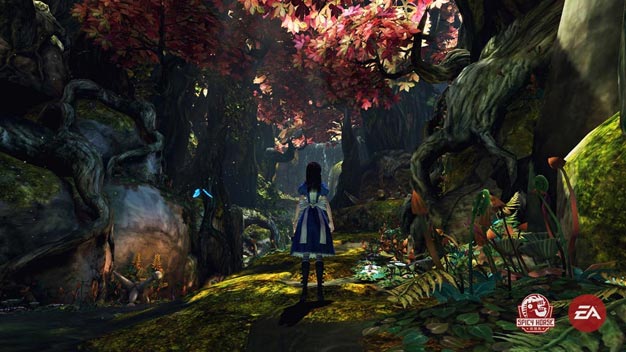
When American McGee’s Alice came out back in 2000, gamers were treated to a wonderfully twisted look into the already-bizarre universe of Wonderland. Now it’s 11 years later, and a sequel is finally hitting store shelves. Despite the long wait, McGee has somehow managed to capture the magic yet again. Alice: Madness Returns does contain some dated design choices, and the gameplay can feel repetitive at times, but the fantastical environments and eerie tone that made the original so great also elevate Madness Returns, resulting in a worthy sequel.
Despite her victories in the original game, Alice is still haunted by the death of her family as Madness Returns starts out. She finds herself in an asylum, and her psychiatrist urges her to let go of the past. But that is no easy task, and Alice soon finds herself back in Wonderland. It’s her job to save this fictional universe again, and by doing so she hopes to save herself and be rid of the torment that consumes her. Along the way, Alice encounters familiar faces such as the Cheshire Cat and the Mad Hatter, and the appropriately strange script makes these characters both interesting and endearing.
Not all of the people Alice meets are friendly, though, which leads to plenty of encounters. The enemies in Madness Returns require specific strategies to defeat, and luckily you will have a few useful tools at your disposal. The primary weapon is the vorpal blade, but along the way you’ll come across some new toys. They include a parasol that lets you deflect incoming attacks and a pepper grinder that acts as a ranged weapon. In addition, all of your weapons can be upgraded with the teeth you collect (essentially the game’s currency). Once you learn to exploit each enemy’s weakness, the battles don’t provide too much of a challenge, but overall, the game provides a surprisingly rewarding combat system.

When you’re not fighting Wonderland’s sinister foes, you’ll be spending most of your time platforming. Luckily this aspect of the game is just as impressive as the combat. Alice is capable of double and triple jumps, and she can also float in the air for a short time. This provides a refreshing level of control, meaning you’ll be overcoming the game’s various obstacles with relative ease. Alice is also capable of shrinking, which is important if you want to find the numerous hidden pathways in each environment. By doing so you’ll come across more teeth, collectible bottles, and lost memories that act as audio logs. The best and most absurd things you’ll come across by searching every nook and cranny, though, are the floating pig snouts. After shooting some pepper at them you’ll be rewarded with additional items.
Although all of the gameplay elements are executed rather effectively, it should also be noted that Madness Returns doesn’t bring anything new to the table, mechanically. Both the combat and platforming are reminiscent of older titles, giving the game somewhat of a dated feel. In addition, Madness Returns doesn’t deviate too much from the core formula. There are occasional attempts at variation, such as a 2D sequence where you control a ship, but these efforts are hit-or-miss and don’t do much to enhance the game’s overall quality.
Normally these gameplay flaws would detract from the experience quite a bit, but the incredible art style in Madness Returns goes a long way. Each chapter in the game brings a new environment, and every single one is compelling. They range from an underwater world to a disturbing dollhouse. The enemies are equally astounding with the likes of red-eyed teapots and cannonball-wielding crabs. Some of the locales and inhabitants found in Wonderland are so strange that they’re difficult to describe, but if there’s one theme that sums it all up, it’s a nightmare. American McGee’s Wonderland is a macabre one where goblins are decapitated in battle and blood covers the floor. When Alice enters hysteria mode and her eyes are painted red, it looks downright terrifying. All of this helps establish a tone that is unsettling but incredibly impressive.
Unfortunately, Madness Returns‘ graphics fall short in the technical department. There is the occasional lack of detail, load times can be too long, and there are quite a few graphical glitches, such as texture pop-in. This is not the same case for the audio though, which is great throughout the entire game. The voice work is solid and the music always suits each situation, whether you’re simply exploring the wondrous lands or fighting off countless enemies.
There are often games out there that can be enjoyed in spite of its flaws, and Alice: Madness Returns is a prime example of that. Both the combat and platforming are good, but there isn’t anything about the gameplay that truly stands out. This leads to some repetition, but it’s hard to get tired of exploring the amazing Wonderland envisioned in this game. Madness Returns is filled to the brim with creative ideas, and though American McGee takes inspiration from the 11 year-old original, the sequel still feels wholly original and unique today.

















